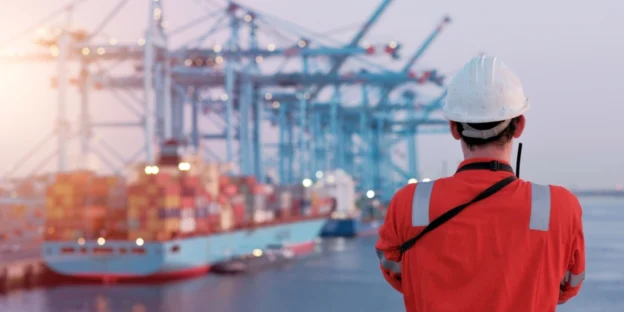Table of Contents
- Critical human factors: evidence 2025
- Why the human factor is important in terminals?
- Non-technical roles and skills in critical operations
- Single buoy operations: Risk controls for personnel
- Competence and training for terminal operators
- Success story: operators transforming results
- Resilience engineering: Build, test, learn
- Human talent at the heart of maritime operations
Maritime terminal operators perform a technical role within the port industry; they represent the essence of safety, efficiency, and continuity of operations. In an environment where large ships, critical cargo, and advanced technological systems coexist, operators’ ability to make accurate decisions marks the difference between excellence and vulnerability.
The human factor, with its skills and values, becomes the engine that drives modern maritime management. Their talent brings resilience, adaptability, and strategic vision, propelling port terminals toward world-class standards.
Critical human factors: evidence 2025
Recently, a study published in 2025 in ScienceDirect reinforced this view by identifying, using the DEMATEL method, the critical human factors that affect maritime safety. The research concluded that staff training, communication, and motivation are key to preventing incidents and sustaining operational continuity in port terminals.
This analysis shows that, even with technological advances in the sector, the real driver of excellence remains the maritime terminal operator. A skilled and resilient workforce not only reduces accidents, but also enhances the effectiveness of systems and protocols, ensuring safer and more efficient operations in the long term.
Why the human factor is important in terminals?
Modern maritime management is supported by advanced infrastructure and digitized control systems. However, behind every successful procedure there is a maritime terminal operator capable of assessing risks, making decisions, and maintaining safety in critical operations. Technology, while indispensable, cannot replace the value of human judgment in situations that require speed, intuition, and experience.
In port terminals, direct supervision and interpretation of contextual signals are irreplaceable. A radar can detect an obstacle, but it is the operator who decides how to act to minimize the impact. Hence, the human factor is understood as a strategic resource that ensures the resilience and sustainability of operations.
Non-technical roles and skills in critical operations
Maritime terminal operators face situations where pressure and responsibility are constant. It is not enough to master the technical aspects of port operations: soft skills such as effective communication, situational leadership, and stress management are required.
A clear example occurs during emergencies. The speed with which an operator transmits information, coordinates with other areas, and maintains calm can mean the difference between a controlled event and a crisis. Maritime management recognizes that these non-technical skills are just as crucial as supervising cargo or docking maneuvers.
Single buoy operations: Risk controls for personnel
Single buoys, used for loading and unloading hydrocarbons, are a critical point in energy logistics. Here, the single buoy operator plays a central role, as they must apply rigorous procedures to prevent incidents that would affect operations and the environment.
Risk control at a single buoy mooring depends on the discipline, training, and constant attention of personnel. Detecting valve anomalies, controlling pressures, or supervising anchoring cannot be delegated solely to sensors. Human intervention ensures that any deviations are identified in a timely manner.
Competence and training for terminal operators
In a constantly evolving port world, professional competence is not achieved through accumulated experience alone. Continuous training is the tool that allows maritime terminal operators to keep up to date with new safety standards, international regulations, and emerging technologies.
The same applies to single buoy operators, who must master both technical operation and environmental protocols. Simulation programs, practical training, and international certifications strengthen staff confidence and effectiveness. Investing in training means reducing incidents and maintaining the competitiveness of port operations.
Success story: operators transforming results
At the Port of Apapa (Nigeria), APM Terminals demonstrated that a well-trained and motivated marine terminal operator can transform operations. Under active supervision and continuous training programs, measures such as a “zero pedestrians” policy in the yard, strict contractor management, and regular safety and resilience training were implemented.
The results speak for themselves:
- – 94% reduction in LTIF (lost time injuries).
- 400 days without LTI (historical record).
- 9,696 man-hours of training in 2023.
- 175 operators trained in Lean/WoW, improving productivity and customer service.
This model of trained, motivated, and recognized operators reduced incidents, optimized processes, and boosted team morale. For supervisors, it meant more autonomous teams, fewer interruptions, and a safe and efficient work environment.
Resilience engineering: Build, test, learn
Resilience engineering has established itself as a pillar of modern maritime management. This approach is based on a clear premise: port systems and the people who operate them must be prepared not only to avoid failures, but also to learn from them and adapt.
At port terminals, resilience involves training staff in high-pressure scenarios, simulating critical failures, and learning lessons that strengthen response capabilities. It is about building organizations capable of absorbing impacts, maintaining operations, and improving key indicators through continuous learning.
Human talent at the heart of maritime operations
Port terminals and single-buoy operations depend on strict protocols and well-designed processes. But behind every cog in the wheel are people. It is human talent that makes maritime management a safe, efficient, and sustainable activity.
Organizational culture, training, and staff resilience are the foundation of operational continuity. They reduce incidents, improve KPIs, and strengthen the trust of customers and communities. Investing in maritime terminal operators means investing in the future of operational excellence.
To achieve these standards, organizations must strengthen training and specialized consulting. Developing skills, training in resilience, and promoting human leadership are decisive steps for port terminals and single buoys to continue to be engines of safe and competitive development.
This article was developed by specialist Mario Toyo and published as part of the sixth edition of Inspenet Brief August 2025, dedicated to technical content in the energy and industrial sector.


